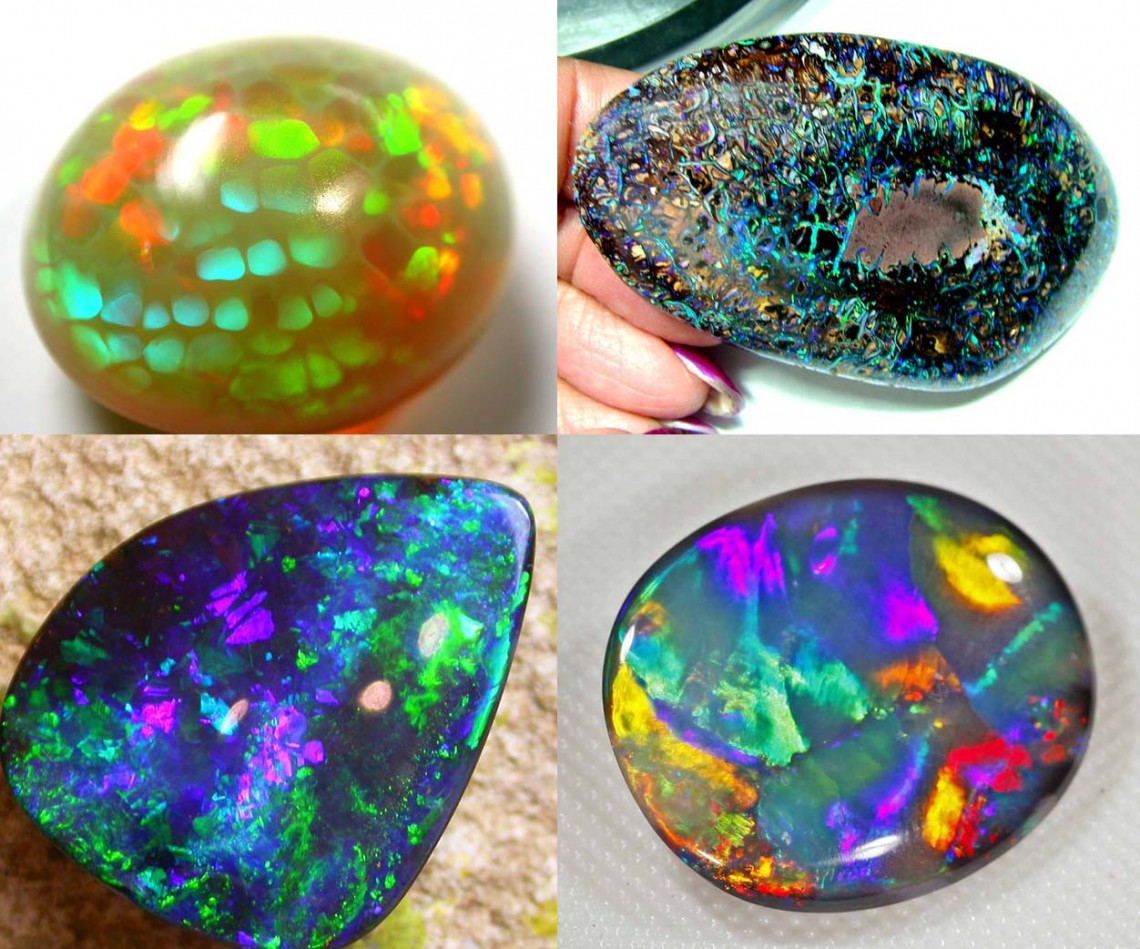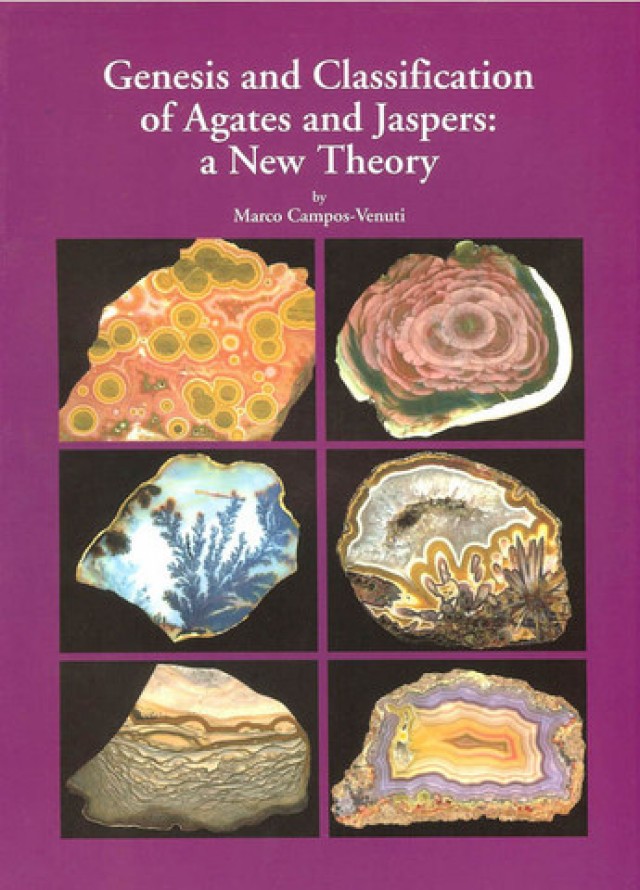
发布时间8th May 2018
修改于17th Nov 2025
蛋白石是如何形成的?
 作为一名前蛋白石矿工,我以前对这个问题不以为意,因为我的职责是推销宝石的美丽,而不是进行化学分析。至今,关于蛋白石的形成方式,甚至它的年龄,仍然没有统一的定论。闪电岭的普遍理论是,富含二氧化硅的水渗入砂岩,填满了空隙和裂缝。之后,水分蒸发,蛋白石凝胶凝固。
作为一名前蛋白石矿工,我以前对这个问题不以为意,因为我的职责是推销宝石的美丽,而不是进行化学分析。至今,关于蛋白石的形成方式,甚至它的年龄,仍然没有统一的定论。闪电岭的普遍理论是,富含二氧化硅的水渗入砂岩,填满了空隙和裂缝。之后,水分蒸发,蛋白石凝胶凝固。
然而,在美国内华达州维尔京谷的蛋白石矿区(也出产黑蛋白石),人们认为富含二氧化硅的热水被推上来,取代了植被,从而形成了蛋白石。
当地人认为维尔京谷的蛋白石大约有5万年的历史,而我们一直认为闪电岭的蛋白石形成于1亿年前的白垩纪时期。发现的蛋白石化的恐龙骨骼、植物和鱼类化石证明了这一点。
有人认为,大约五百万年的时间才形成了一厘米(略多于三分之一英寸)厚的蛋白石;这可能是由于雨水将二氧化硅凝胶冲刷到蛋白石泥土中形成的。
这是基于这样一种理论:在闪电岭发现的大部分化石都来自白垩纪时期。
然而现在许多人认为,化石空隙可能是在很久以后才被蛋白石取代的,有些人甚至认为它的年龄可能不到 10 万年。

博尔德蛋白石
昆士兰州发现的蛋白石巨石的形成方式与其他类型的澳大利亚蛋白石略有不同,它形成于铁矿石结核内部。这种结核的形成是由于沉积物中的离子化作用。
美国爱达荷州斯宾塞蛋白石矿中的蛋白石溶液或二氧化硅是由间歇泉活动携带的次生矿床。
由于多次火山喷发,蛋白石呈层状分布。大部分层都很薄,造就了世界上最美丽的几层蛋白石。蛋白石在空心晶洞内经热液沉积,一层层堆积,使得斯宾塞蛋白石成为三层蛋白石的理想产地,因为这些极薄的高品质珍贵蛋白石层非常透明,且色彩浓郁。
化学条件
蛋白石的形成化学条件仍在研究中,但一些学者认为,在形成二氧化硅球的过程中,某个阶段必须存在酸性环境,而二氧化硅球可能由微生物产生。此外,人们还认为氧化铝、氧化铁或氧化镁,以及氯化钠或硫酸钠的存在也是必要的。
新南威尔士州初级产业部认为,微生物可能在蛋白石的形成过程中发挥了作用。在白垩纪沉积物形成之时,某些沉积物中丰富的有机质和蒙脱石(也称蒙脱石)粘土为微生物提供了理想的栖息地,供其觅食和繁殖。微生物分泌的废酸和酶导致周围岩石中的粘土矿物和长石发生化学风化。最终,微生物持续的摄食和排泄过程为蛋白石的形成创造了有利的物理和化学条件。
生长中的蛋白石
蛋白石是在装有电解液(一种带电荷的化学溶液)的容器中人工培育的,需要数周时间才能显现颜色。它只是一种凝胶状物质,并未硬化。人们认为这种过程在自然界中也存在,这可以解释蛋白石是如何进入火山凝灰岩内部或出现在果核中心的。
CSIRO对蛋白石颜色形成的研究
桑德斯博士利用电子显微镜发现,蛋白石是由数百万个排列规则的微小二氧化硅球组成的。在这些球体之间,存在着更小的孔洞或缝隙,光线会通过这些孔洞发生衍射,也就是说,当白光或普通阳光穿过这些孔洞时,光线会被分解成不同的颜色。在球体较小的蛋白石中,产生的颜色是彩虹中较深的颜色——紫色、靛蓝色和蓝色。当球体较大时,则会产生黄色、橙色和红色。当球体排列规则时,便形成了珍贵的蛋白石。而普通蛋白石则没有固定的排列模式。似乎在不同的产地,蛋白石的形成受到多种不同因素的影响,从而形成了具有独特特征的蛋白石。我仍然认为这是一种自然界的奥秘或魔法,让我们尽情欣赏它的美丽吧。
蛋白石是如何形成的——一位火山学家的观点
作者马可·坎波斯·韦努蒂(Marco Campos Venuti)刚刚出版了一本新书,名为《玛瑙和碧玉的成因与分类》。作者是一位火山学博士,也是《意大利宝石学》(Gemmologica Italiana)的作者。感谢马可·坎波斯授权转载。

蛋白石是一种硬化的二氧化硅凝胶,化学式为SiO2·nH2O,由浓缩溶液沉积而成。在硅藻、放射虫、海绵和许多维管植物等产生有机蛋白石的生物体中,硅酸会在特殊的细胞区室中积累,其中特定的蛋白质会诱导蛋白石-A的沉淀。
无机蛋白石的形成则是由多种因素共同作用的结果。首先,需要富含二氧化硅的土壤,这种土壤常见于火山地区,或富含石英的沙层中。其次,通常需要极强的碱性pH值(>9)才能促进高浓度硅酸盐水的形成。此外,还需要地下水位具有显著的季节性波动,以利于二氧化硅的富集。最后,还需要一种催化因子来促使二氧化硅沉淀。催化作用可以通过温度升高、pH值变为酸性,或某些分子(例如氧化铁、氧化铝、氧化镁、硫酸钠或海盐)的存在来启动。
当蛋白石的前体以粘稠固体的形式沉积时,其孔隙率可能超过35%,部分孔隙被水占据。如果样品干燥,它会碎裂并不可逆转地变成白色粉末。这是合成蛋白石生产中遇到的主要问题。在实验室中,必须用某种不会改变蛋白石光学性质的树脂填充这些孔隙。自然界中使用的是其他类型的硅胶,这些硅胶在大多数情况下会降低蛋白石的品质。成岩作用也可以驱动矿物蛋白石向碧玉的转变。

让我们用通俗易懂的方式解释一下上面的一些术语。
硅藻
硅藻是具有独特透明细胞壁的藻类,细胞壁由二氧化硅和少量水(SiO2 + H2O)组成。
放射线虫
它们是变形虫状的原生动物,能够产生复杂的矿物骨骼。
硅酸
(H4SiO4)是海洋中的一种重要营养物质。
盐水
盐水是盐的水溶液。在不同的语境中,盐水可以指代盐溶液。
无机蛋白石
传统观点认为,无机化合物是由地质系统合成的。与之相反,有机化合物则存在于生物系统中。
选购蛋白石
搜索Opal Encyclopedia
最新的文章
文章分类
All there is to know about Opals including Black Opals, Ethiopian Opals & Boulder Opal
14文章数
Check out our fascinating information and articles on all things amazing in the Opal world
41文章数




